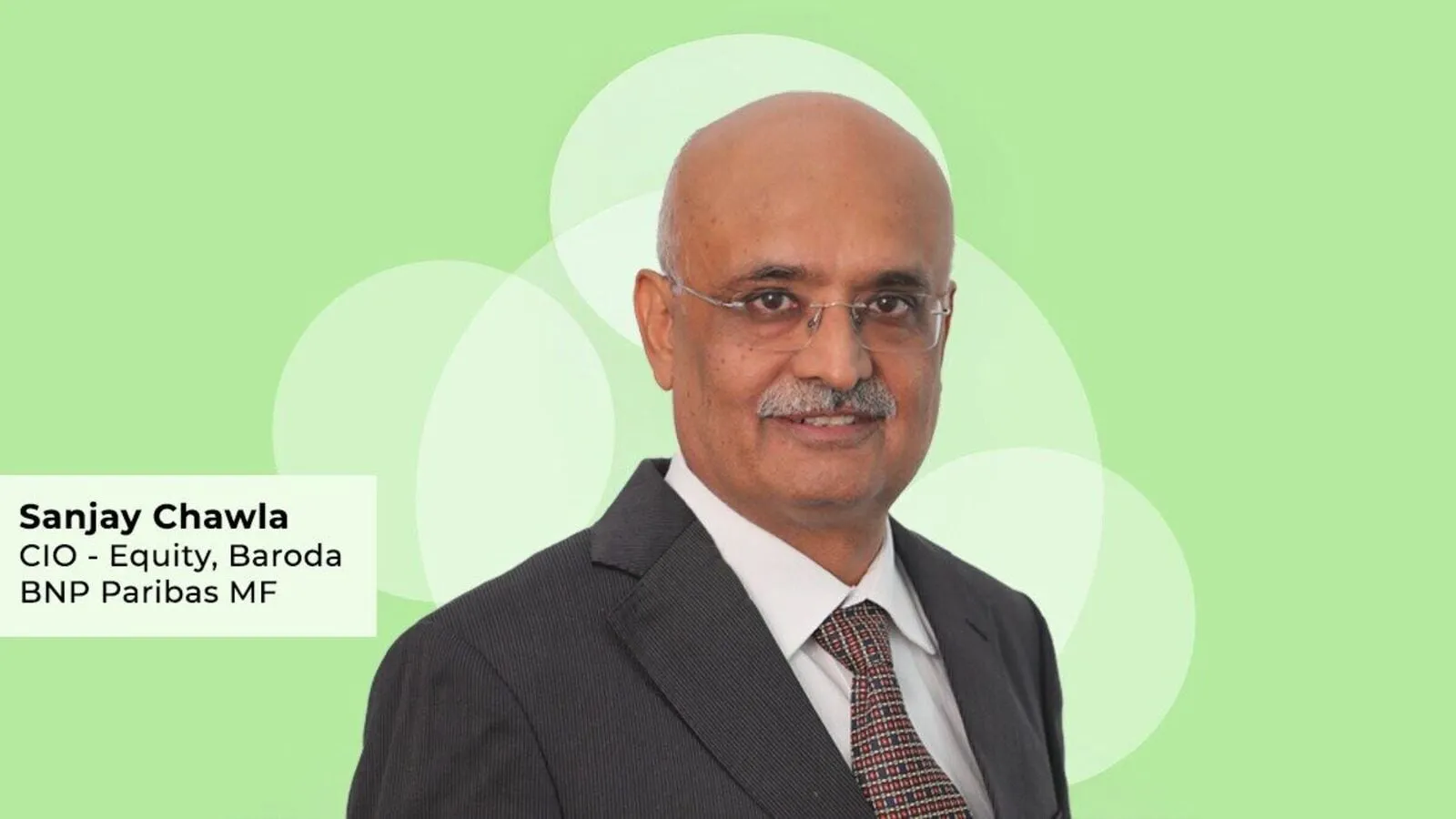RBI rate cuts, fiscal support likely to aid FY26 earnings recovery: Sanjay Chawla of Baroda BNP Paribas MF

Expert view on markets: Sanjay Chawla, CIO – Equity at Baroda BNP Paribas Mutual Fund, believes RBI rate cut and government support may ensure a recovery in growth and earnings for FY26 over FY25. In an interview with Mint, Chawla spoke about market triggers, RBI rate cuts, mid and small-cap segments and sectors. Here are edited excerpts of the interview:
What is your outlook for the market? What are the key triggers that will shape it in the medium term?
Overall, the earnings adjustment in the market for softer growth seems to be discounted.
With broader markets now trading in line with their long-term forward multiples, a lot of froth has drained out of them.
We expect further support from the monetary authority in India, the RBI.
Recent measures of infusing system liquidity, relaxing credit-deposit (CD) norms, and some marginal dilution on provisioning norms seem to be precursors to potential rate easing soon.
This may also be aided by some fiscal measures. We have witnessed a pickup in order announcements, especially in defence, power, etc.
The tax cuts announced in the Union Budget 2025 will take effect from FY26. All these measures are expected to ensure a recovery in growth and earnings for FY26 over FY25.
Hence, fundamentally, we are relatively more constructive on markets than we were a couple of quarters back.
A few factors that may impact the markets are more external to India: volatility stemming from global factors, e.g., the effects of the “Trump tariffs.”
Closer home, we may need to keep an eye on the monsoon prognosis, which the IMD typically puts out by the end of April, given the hot summers being witnessed. This may have a bearing on the RBI’s potential rate-cut trajectory.
Do you believe equity as an asset class will continue underperforming safe havens in FY26?
FY25 was a year of two halves, with returns delivered in the first half (H1) only to be clawed back in the second half. We believe that FY26 can be a year of two halves as well.
We enter the fiscal year with many uncertainties on the global macro front, underlined by impending reciprocal tariffs to be levied by the USA.
Added to that is the potential reaction of other countries to the USA tariffs. Also, there have been some concerns about the domestic economy related to the slowing down of government capex, weak urban demand, and less-than-impressive corporate earnings growth.
We believe that many domestic concerns will recede through the first half of the current financial year (H1FY26), and new terms of trade at the global level have also been established.
Consequently, we expect significant improvement in investor sentiment as we commence H2FY26. Overall, we expect the market’s return profile to improve through FY26.
What’s your take on the valuations of mid and small-caps? Should we be cautious?
Investing in mid and small-caps (SMID) is always a bottom-up exercise; hence, it’s tricky to paint the entire space with the same brush.
We believe that the risks in the mid-and small-cap are not from paying high valuations but more from lofty earnings growth assumptions.
The crux of investing in the SMID space is to find the right blend of management capabilities, scalability, risk assessment, and valuations.
When we evaluate companies across these parameters, we still find enough opportunities in the SMID space. This is going to be more of a bottom-up market.
In the long run, SMID is expected to remain one of the best spaces for investors’ wealth creation.
What are your expectations from Q4 earnings? Is a significant revival in earnings still far?
Throughout the last financial year, we observed moderate earnings growth for Nifty 500 companies. However, Q3 did show some improvement, with large-cap and mid-cap reporting an improvement in growth trajectory.
We expect earnings growth momentum to improve. Market participants may not be disappointed for the March quarter, especially given the disappointing H1.
FY26, though, carries hopes considering a favourable base. There are a number of reasons for being more optimistic for the coming year: a potential pickup in domestic growth led by a consumption uptick, the Union Budget cutting the tax rate may lead to more money in the hands of consumers, the flow-through benefit of recent RBI policies, and a potential pick-up in capital expenditure in coming quarters.
Do you expect the RBI to cut the rate by more than 100 bps in the current rate reduction cycle?
The RBI has consistently emphasized that price stability, particularly in terms of controlling inflation, is the primary factor influencing decisions regarding the Repo rate.
The RBI considers an inflation target range of 4% ± 2% as the acceptable threshold for adjusting interest rates.
In the current monetary policy cycle, the RBI reduced the Cash Reserve Ratio (CRR) by 50 basis points in December 2024, followed by a 25-basis point cut in the Repo rate in February 2025.
Nevertheless, the decision to lower rates is also influenced by the global economic landscape, currency fluctuations, external factors, and domestic demand conditions.
While domestic inflation remains manageable, geopolitical tensions and tariff uncertainties may provoke discussions among MPC members.
In the previous cycle, from January 2019 to November 2019, the cumulative rate reduction was 135 basis points; however, in the current cycle, the extent of rate cuts may largely hinge on geopolitical crises and tariff uncertainties.
What sectors are you looking at amid heightened global uncertainty?
Amid heightened global uncertainty, we are focused on companies having clearer visibility on earnings and cash flow growth.
With a pullback, valuations have become comfortable across all market-cap segments. We see a large cap segment in a value zone with valuations closer to bottom valuations over the past seven years.
As against, the mid-cap segment is closer to average, and the small-cap segment is marginally below-average valuations.
Outlook-wise, we are focussing on domestic plays and structural themes due to the potential slowdown in the global economy due to tariffs and likely counter-tariffs.
Pharma and healthcare are interesting plays. Consumption may come into focus in the coming quarters after the tax break given in the Union Budget.
Finally, if infrastructure spending is picked up as the Budget, the capital goods sector may sustain the current valuations.
One sector that may benefit from potentially lower system costs is the banking industry.
In recent times, the industry has struggled to garner deposits at optimum cost. With the major margin compression impediment out and valuations at historic lows, this sector is expected to have favourable risk-reward.
Is IT a sector worth looking at now?
IT sector correction recently led by concerns about US GDP growth. The Trump tariff may potentially have a second-level derivative impact on US inflation and consumer spending.
This may delay firming up IT budgets or spending by US corporations. Consequently, revenue recovery could be delayed by a quarter or so.
While sector valuations, post-recent corrections, have turned attractive, concerns on the US macro would need to recede to be constructive on the sector.
What should be our investment strategy during volatile times?
Equity markets are inherently volatile over a short period.
Historically, we have seen that Equity markets are slaves to earnings. Earnings are driven by growth in the economy.
Barring a marginal economic slowdown, we expect the Indian economy to be on a structural growth path.
In such a scenario, it is best to capitalise during such volatile times. Wealth can be created during bear markets and encashed during markets.
Investors should have a disciplined approach to asset allocation and must stick to it.
If possible, investor can capitalize on these volatile times, if possible, increase more allocation towards equity.
The good news is that this volatility is not based on domestic factors.
Once these issues settle down, we expect earnings growth to start inching up and markets to keep pace.
Read all market-related news here
Read more stories by Nishant Kumar
Disclaimer: This story is for educational purposes only. The views and recommendations above are those of individual analysts or broking companies, not Mint. We advise investors to check with certified experts before making any investment decisions, as market conditions can change rapidly, and circumstances may vary.










